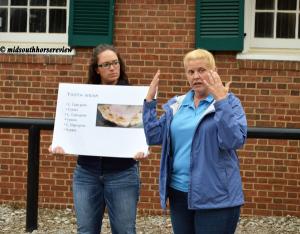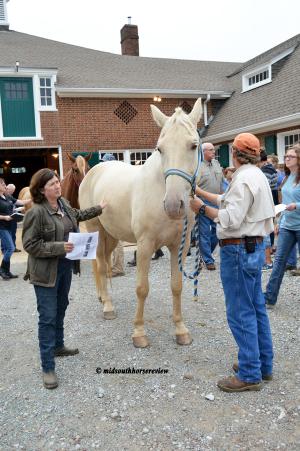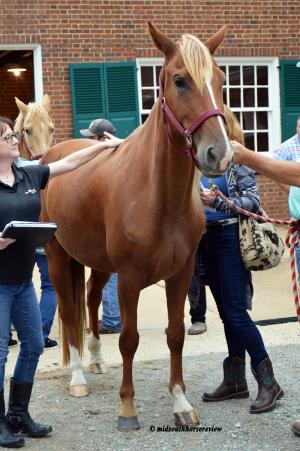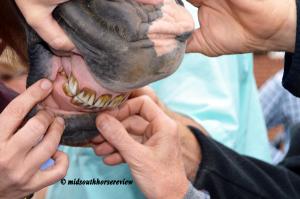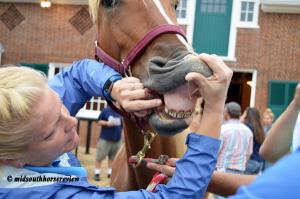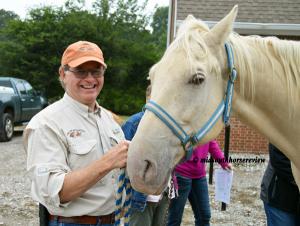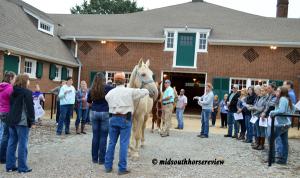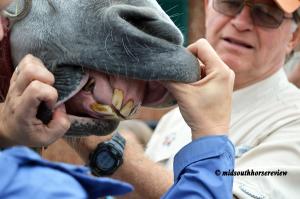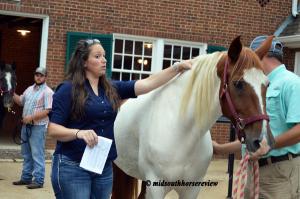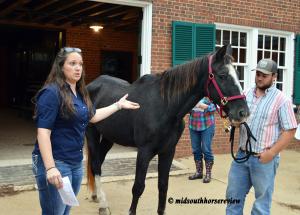By Nancy Brannon, Ph.D.
The University of Tennessee Institute of Agriculture offers field days every year on a variety of topics. For the third year, the 2018 field day schedule included events devoted to horse management and everything equine.
Covering three regions in the state on three Thursdays in September, horse owners and equine enthusiasts could learn about several facets of horse management. UT Extension veterinarian Lew Strickland, UT Extension equine specialist Jennie Ivey and others discussed horse management topics ranging from body condition scoring to dental aging to deworming recommendations. Each event was scheduled from 4 p.m. to 8 p.m. local time and included dinner. Dates and locations were:
September 13, UTIA Campus, Brehm Animal Science Building in Knoxville
September 20, Middle Tennessee AgResearch and Education Center in Spring Hill
September 27, Ames Plantation in Grand Junction
Ivey said she had had requests for more hands-on programs, so this field day was very hands-on! The September 27th field day at Ames Plantation began at the 105-year-old historic Brick Stables. Dr. Amy Weatherly, resident veterinarian of Wolf River Veterinary Services, began with an explanation of horses’ teeth: how they grow, from baby teeth to permanent teeth; how they change over the years through use; particular characteristics of teeth at stages of the horse’s life, such as Galvayne’s groove; how they grind food and why floating is sometimes necessary to smooth out sharp edges. Ever wonder where the phrase “long in the tooth” to describe older horses comes from? It accurately describes the elongated angle of the teeth of older horses, as compared to the straighter angle in younger horses.
Next on the agenda was learning about the Body Condition Score (BCS), presented by Dr. Jennie Ivey. Developed by Dr. Don Henneke and his colleagues in 1983, the BCS is a helpful tool in assessing and managing the body weight of horses. The BCS evaluates six specific regions over the horse’s body where predictable patterns of fat deposition are found: the crest of the neck, along the withers, behind the shoulder, over the ribs, loin and tailhead. Visual and tactile evaluation of these areas on both sides of the horse is key to determining BCS. Once the amount of fat coverage over each area is determined, the BCS is a given a numerical value, ranging from 1 (emaciated – skin and bones) to 9 (obese).
Attendees were given a summary handout on the Body Condition Scoring System and a card about teeth, and then it was time to apply that information to real horses.
Ames Director Dr. Rick Carlisle and his staff brought out several of Ames’ horses for folks examine their teeth and determine a BCS for each. With some assistance from Dr. Weatherly and Dr. Ivey, attendees made fairly accurate assessments of the horses’ ages and BCS.
Finishing this part of the program around dinner time, folks went to Bryan Hall, where a BBQ dinner from Loven-Fresh Smokehouse Barbeque in Oakland, Tennessee awaited.
On display in Bryan Hall were four types of equine parasites, which would be discussed after dinner in conjunction with information on fecal egg counts: equine pinworms, roundworms, stomach worms, and bots. After eating, folks were asked to fill a measuring scoop and weigh two of the four types of feed Ivey had on display – extruded, cracked corn, sweet feed, pellets – and record the weight on a card. The scoops were all identical.
While folks were digesting their dinner, it was time to learn about the horse’s digestive system. Ivey had volunteers from the audience represent each part of the system. She began with a 100-foot water horse that stretched from one end of Bryan Hall to the other. The first volunteer got to be the mouth, where food first enters the body. The next represented the esophagus with a stiff piece of pipe insulation wrapped around the section of the hose just past the mouth. Then came the stomach, represented by a volunteer holding 2-gallon plastic jug. Folks could easily see how small the horse’s stomach is compared to the rest of the system.
The stomach is followed by the small intestine, which is 70 feet long, but small in diameter, about 2-4 inches, where most of the fermentation and digestion takes place. The small intestine is composed of 3 sections; the duodenum, jejunum and the ileum. After the feed has been digested, it is absorbed through the walls of the small intestine and carried off by the blood stream to the cells that need the nutrients. Nearly 30-60% of carbohydrate digestion and absorption and almost all amino acid absorption occur in the small intestine.
Finishing the digestive system is the hindgut or large intestine, as it is commonly called, which consists of the caecum, large colon, small colon, rectum, and anus. This section needed three volunteers, with one lucky volunteer holding the fecal balls.
The caecum is a microbial inoculation vat. Here microbes break down feed that was not digested in the small intestine, particularly fibrous feeds like hay or pasture. The caecum was represented by a large garbage bag, and the caecum can hold onto water as a hydration reservoir.
The large colon was represented by a dryer duct, 10-12 feet in length. Here is where veterinarians listen for gut sounds when it is suspected the horse may be in colic. It bends, twists, and turns in ways that food may get stuck. In the large colon microbial digestion (fermentation) continues, and most of the nutrients made through microbial digestion are absorbed here, as well as B group vitamins produced by the bacteria and some trace minerals and phosphorous.
The small colon is approximately the same length as the large colon, but only has a diameter of about 10cm. By now the vast majority of the nutrients have been digested, and what is left cannot be digested or used by the horse. The main function of the small colon is to reclaim excess moisture and return it to the body. Here is where fecal balls are formed. Fecal balls are the undigested and mostly indigestible portion of what was fed some 36-72 hours before, and are then passed to the rectum and expelled as manure through the anus.
By now, folks were beginning to see how all this fit together. Dental health, food and digestion, parasites, all of which determines the horse’s body condition.
Now – what are we feeding our horses? It was interesting to see how varied the recorded weights of the feed types were: scoops were all the same size and comparisons were made within each feed group. Ivey explained the importance of feeding horses by weight, as weights also vary between feeds depending on the type of concentrate. A good feeding program begins with quality forage and then concentrates are added to make up for the nutrients the forage lacks.
Last on the agenda was a discussion of equine parasites and how to control them to maintain your horse’s health. Ivey asked how many people were still deworming every three months and rotating dewormers? She said, “We haven’t recommended doing that for 30 years.” The problem is that some resistance to dewormers has occurred, and there are no new dewormers on the horizon. It is more effective to determine exactly what parasites horses have and then to target them with a parasite-specific dewormer. Horses are now typed as low shedders, moderate shedders, and high shedders. She said the majority of the transmission of parasites is done by just 10%-15% of the horse population – the high shedders.
Ivey walked folks through how to do a fecal egg count, and then it was time to get out the tubes, take a sample of manure, wait for the eggs to rise to the surface, and then look at the sample on a slide under the microscope. She had shown photos on the screen of what particular parasites look like under a microscope so folks would have a better idea of what they were looking at on their own slide.
There was plenty of written information to take home: a horse parasite control handout and one on major internal parasites affecting horses. Ivey brought additional information on West Nile Virus, since fall is also mosquito season, and a handout on the horse’s hoof. Folks could also take home packets of lettuce seeds for their fall gardens – all conveniently fit into a recyclable orange UT Institute of Agriculture bag.
If you would like more information about horse management topics, contact Jennie Ivey at 865-974-3157 or by email at jzivey@utk.edu​. Visit the website: UTHorse.com and facebook: Horse Programs at the University of Tennessee.
The University of Tennessee Institute of Agriculture offers field days every year on a variety of topics. For the third year, the 2018 field day schedule included events devoted to horse management and everything equine.
Covering three regions in the state on three Thursdays in September, horse owners and equine enthusiasts could learn about several facets of horse management. UT Extension veterinarian Lew Strickland, UT Extension equine specialist Jennie Ivey and others discussed horse management topics ranging from body condition scoring to dental aging to deworming recommendations. Each event was scheduled from 4 p.m. to 8 p.m. local time and included dinner. Dates and locations were:
September 13, UTIA Campus, Brehm Animal Science Building in Knoxville
September 20, Middle Tennessee AgResearch and Education Center in Spring Hill
September 27, Ames Plantation in Grand Junction
Ivey said she had had requests for more hands-on programs, so this field day was very hands-on! The September 27th field day at Ames Plantation began at the 105-year-old historic Brick Stables. Dr. Amy Weatherly, resident veterinarian of Wolf River Veterinary Services, began with an explanation of horses’ teeth: how they grow, from baby teeth to permanent teeth; how they change over the years through use; particular characteristics of teeth at stages of the horse’s life, such as Galvayne’s groove; how they grind food and why floating is sometimes necessary to smooth out sharp edges. Ever wonder where the phrase “long in the tooth” to describe older horses comes from? It accurately describes the elongated angle of the teeth of older horses, as compared to the straighter angle in younger horses.
Next on the agenda was learning about the Body Condition Score (BCS), presented by Dr. Jennie Ivey. Developed by Dr. Don Henneke and his colleagues in 1983, the BCS is a helpful tool in assessing and managing the body weight of horses. The BCS evaluates six specific regions over the horse’s body where predictable patterns of fat deposition are found: the crest of the neck, along the withers, behind the shoulder, over the ribs, loin and tailhead. Visual and tactile evaluation of these areas on both sides of the horse is key to determining BCS. Once the amount of fat coverage over each area is determined, the BCS is a given a numerical value, ranging from 1 (emaciated – skin and bones) to 9 (obese).
Attendees were given a summary handout on the Body Condition Scoring System and a card about teeth, and then it was time to apply that information to real horses.
Ames Director Dr. Rick Carlisle and his staff brought out several of Ames’ horses for folks examine their teeth and determine a BCS for each. With some assistance from Dr. Weatherly and Dr. Ivey, attendees made fairly accurate assessments of the horses’ ages and BCS.
Finishing this part of the program around dinner time, folks went to Bryan Hall, where a BBQ dinner from Loven-Fresh Smokehouse Barbeque in Oakland, Tennessee awaited.
On display in Bryan Hall were four types of equine parasites, which would be discussed after dinner in conjunction with information on fecal egg counts: equine pinworms, roundworms, stomach worms, and bots. After eating, folks were asked to fill a measuring scoop and weigh two of the four types of feed Ivey had on display – extruded, cracked corn, sweet feed, pellets – and record the weight on a card. The scoops were all identical.
While folks were digesting their dinner, it was time to learn about the horse’s digestive system. Ivey had volunteers from the audience represent each part of the system. She began with a 100-foot water horse that stretched from one end of Bryan Hall to the other. The first volunteer got to be the mouth, where food first enters the body. The next represented the esophagus with a stiff piece of pipe insulation wrapped around the section of the hose just past the mouth. Then came the stomach, represented by a volunteer holding 2-gallon plastic jug. Folks could easily see how small the horse’s stomach is compared to the rest of the system.
The stomach is followed by the small intestine, which is 70 feet long, but small in diameter, about 2-4 inches, where most of the fermentation and digestion takes place. The small intestine is composed of 3 sections; the duodenum, jejunum and the ileum. After the feed has been digested, it is absorbed through the walls of the small intestine and carried off by the blood stream to the cells that need the nutrients. Nearly 30-60% of carbohydrate digestion and absorption and almost all amino acid absorption occur in the small intestine.
Finishing the digestive system is the hindgut or large intestine, as it is commonly called, which consists of the caecum, large colon, small colon, rectum, and anus. This section needed three volunteers, with one lucky volunteer holding the fecal balls.
The caecum is a microbial inoculation vat. Here microbes break down feed that was not digested in the small intestine, particularly fibrous feeds like hay or pasture. The caecum was represented by a large garbage bag, and the caecum can hold onto water as a hydration reservoir.
The large colon was represented by a dryer duct, 10-12 feet in length. Here is where veterinarians listen for gut sounds when it is suspected the horse may be in colic. It bends, twists, and turns in ways that food may get stuck. In the large colon microbial digestion (fermentation) continues, and most of the nutrients made through microbial digestion are absorbed here, as well as B group vitamins produced by the bacteria and some trace minerals and phosphorous.
The small colon is approximately the same length as the large colon, but only has a diameter of about 10cm. By now the vast majority of the nutrients have been digested, and what is left cannot be digested or used by the horse. The main function of the small colon is to reclaim excess moisture and return it to the body. Here is where fecal balls are formed. Fecal balls are the undigested and mostly indigestible portion of what was fed some 36-72 hours before, and are then passed to the rectum and expelled as manure through the anus.
By now, folks were beginning to see how all this fit together. Dental health, food and digestion, parasites, all of which determines the horse’s body condition.
Now – what are we feeding our horses? It was interesting to see how varied the recorded weights of the feed types were: scoops were all the same size and comparisons were made within each feed group. Ivey explained the importance of feeding horses by weight, as weights also vary between feeds depending on the type of concentrate. A good feeding program begins with quality forage and then concentrates are added to make up for the nutrients the forage lacks.
Last on the agenda was a discussion of equine parasites and how to control them to maintain your horse’s health. Ivey asked how many people were still deworming every three months and rotating dewormers? She said, “We haven’t recommended doing that for 30 years.” The problem is that some resistance to dewormers has occurred, and there are no new dewormers on the horizon. It is more effective to determine exactly what parasites horses have and then to target them with a parasite-specific dewormer. Horses are now typed as low shedders, moderate shedders, and high shedders. She said the majority of the transmission of parasites is done by just 10%-15% of the horse population – the high shedders.
Ivey walked folks through how to do a fecal egg count, and then it was time to get out the tubes, take a sample of manure, wait for the eggs to rise to the surface, and then look at the sample on a slide under the microscope. She had shown photos on the screen of what particular parasites look like under a microscope so folks would have a better idea of what they were looking at on their own slide.
There was plenty of written information to take home: a horse parasite control handout and one on major internal parasites affecting horses. Ivey brought additional information on West Nile Virus, since fall is also mosquito season, and a handout on the horse’s hoof. Folks could also take home packets of lettuce seeds for their fall gardens – all conveniently fit into a recyclable orange UT Institute of Agriculture bag.
If you would like more information about horse management topics, contact Jennie Ivey at 865-974-3157 or by email at jzivey@utk.edu​. Visit the website: UTHorse.com and facebook: Horse Programs at the University of Tennessee.
